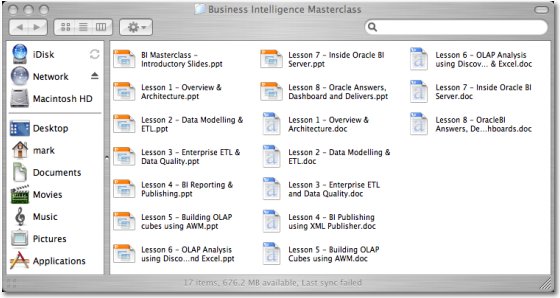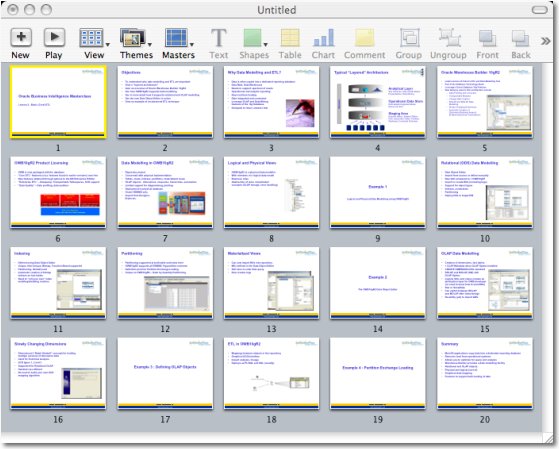Finally Finished
Well, that's finally finished now. After about two months of effort, mostly in the evenings and on train journeys to and from London, I've finally finished the course material for the seminar series I'm starting next week.

The normal routine I go through when doing a new presentation is to first put together the slides, to give the talk some structure and pull together some illustrations. Then I put a couple of examples together, which I screenshot and write-up in an accompanying Word document. Finally, I add to the document a write-up for each slide, so that I end up with a conference paper that "tells a story", which usually involves going back and reworking some of the slides to make the presentation flow better. On average, it takes me at least a couple of weeks to prepare a presentation in this way, and I took the same approach with each of the seminar lessons to ensure the quality was up to scratch.

All told, it took me about two and a half months to put all the material together, a bit longer than I expected actually as the seminar is aimed at a technical audience who are already familiar with at least some of the tools. I did actually think when I accepted the invitation that I could re-use the presentations that I've given over the past couple of years, but looking back at these they were mostly written when the products concerned were new, and I wanted to rewrite them to build in the experience I've built up since then at various customer sites, and to make them flow together better as an end-to-end business intelligence story.
For those of you who are interested, I built the examples and the course material using my new MacBook, using Parallels Desktop running Windows XP SP2 as the virtual machine. Up until recently I'd been using Centos as my guest OS, but the Siebel Analytics element of the tech stack currently only runs on Windows (and Solaris, HP UX) with the Linux port coming soon, so it made sense to standardize on Windows until I can move the whole lot over. I mostly used Powerpoint and Word, either on the Mac or in the Windows virtual machine, to put the material together, more out of familiarity than anything, but I've just shelled out for iWork'06 and I'll probably move over to Keynote and Pages now, if only so I can use the fancy Mac remote to control the Keynote slideshow during my talks (how shallow...)
I'm just finishing off this week with our current client (working opposite Lisa Dobson actually, who's actually project managing me - she's a hard taskmaster although she keeps slipping out to Starbucks across the road for a coffee) and then I'm flying out on Monday for the first seminar on Tuesday in Holland. This first one should be interesting as I've probably got more material than I can deliver in two days, on the basis that I won't know until the day what the experience level of the attendees will be, nor their particular areas of interest. I guess after a few iterations a pattern will emerge, but from what I know about the Dutch guys I know (the AMIS people for example) they're a pretty switched on and clued up bunch over there, so it should be interesting.
I'm trying to work out now what to do with the course material once the series is over, later next year. The altruistic part of me thinks I should just bundle it up in PDF and make it a free download, but I have been giving some thought, now that the bulk of the hard work is done, into tidying it up, adding some addition chapters around say Discoverer relational, Data Mining and so on and trying to get it published. Looking at other books, one thing I need to do is to generate my own example dataset and scenarios, rather than just re-use the SH, OE, HR etc schemas, but it might not be a bad idea, especially if I can incorporate some of the feedback, ideas etc that delegates come up with during the seminars. We shall see.
Of course now, I've suddently got a bit of free time, although no doubt before each seminar starts I'll be frantically re-reading my notes, making sure the examples work and trying to remember all the sagely comments I'd written down but no doubt will forget as soon as I start speaking. However, it does give me the chance to start looking at some things I've been putting to one side over the last two months or so, including:
- Getting "under the covers" with OS X, particularly looking at Fink, the BSD underpinnings, Automator/applescript and so on
- Looking in more detail at some of the more tricky BI Suite EE features, such as Disconnected Analytics, including additional content in Dashboards / using the "Guided Analytics" feature to conditionally display dashboard content, bringing in unstructured / MDX data
- Trying to get myself on the 11g beta, in particular to see what they've got planned for the OLAP Option (I sort of know, but it'd be good to see how they've implemented it)
- Take a look at some of the more exotic OWB10gR2 features such as Experts, interactive impact analysis and so on
- Try out some performance tuning scenarios with the BI Server, in particular how to optimize/tune the SQL that it emits, whether there's a best way to combine data from two different datasources, pre-seed the cache using Delivers, how to use clustering and so on
There's also the small matter of one of the presentations I'm giving at the UKOUG Conference this November, on comparing the performance of Analytic Workspaces and Materialized View in a data warehouse environment. This was the paper that I submitted for HotSos last year, got initially rejected then accepted when a couple of people dropped out, unfortunately it was a bit too late in the day and I didn't have enough time to do the neccessary experimentation. It's been accepted now for the UKOUG event (should be a DBA audience, first time in this stream rather than the BI&W one) and I'll resubmit it, with a couple of changes, for HotSos again this year. The basic premise is that as an alternative to aggregating data in a materialized view, you can create an Analytic Workspace and then place a denormalized, SQL View over it and achieve much the same result, except that (in theory) the Analytic Workspace should be faster to "roll up", query and so on. To be honest, I've no idea if this premise is valid or not, hence the paper, so It'll be an interesting exercise especially if approached with the "rigour" of a HotSos-quality paper. Thinking ahead, one issue I'm probably going to have is trying to get hold of a suitably large dataset - you can test it on the SH, Global Schemas etc but the differences often only become apparent when you scale up into the hundreds of terabytes and above. I'll have to see if I can simulate something using multiple copies o of the SH schema rolled back into itself, or if any of our customers have a handy terabyte star schema that I can do some experiments on.
Anyway, that's it for now. As I say, I'm working with Lisa up in London at the moment, having some fun and games with the Match-Merge feature in OWB10gR2 (warning, if you're looking to match but not merge, or the amount of values you wish to test against is greater than 1000, you're in for a bit of a suprise) but then after that it's a case of packing my suitcase and off to Holland. Should be good.